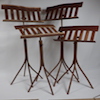I just got my tools out of storage where they've been since mid April. I expected to see surface rust on tool beds but I hadn't thought about the spiral head on my jointer. See photo below. I know how to handle the surface rust but I'm not sure how to proceed on the head. I'm thinking about wiping with a rag saturated with Evapo-Rust, letting it sit overnight and then wiping down thoroughly but your suggestions would be greatly appreciated.
Thanks!
rust on spiral head.jpg





 Reply With Quote
Reply With Quote




 It should only take 10 minutes or so if you have the skills...
It should only take 10 minutes or so if you have the skills...
